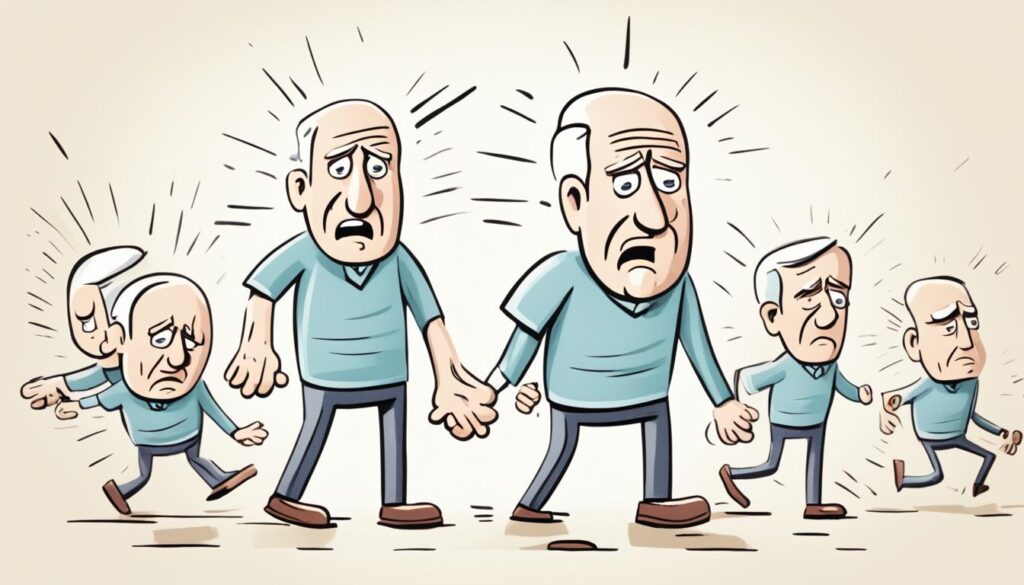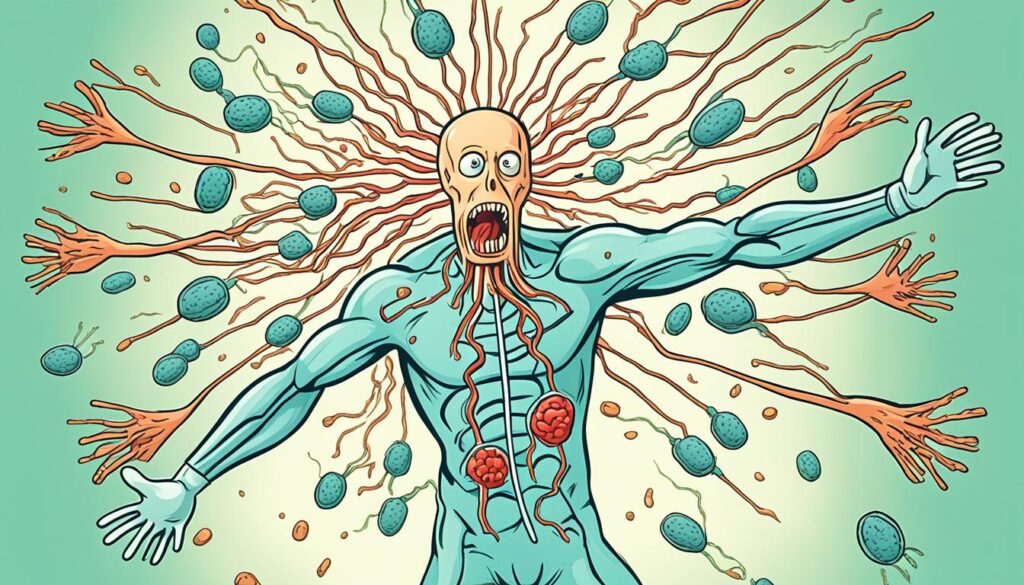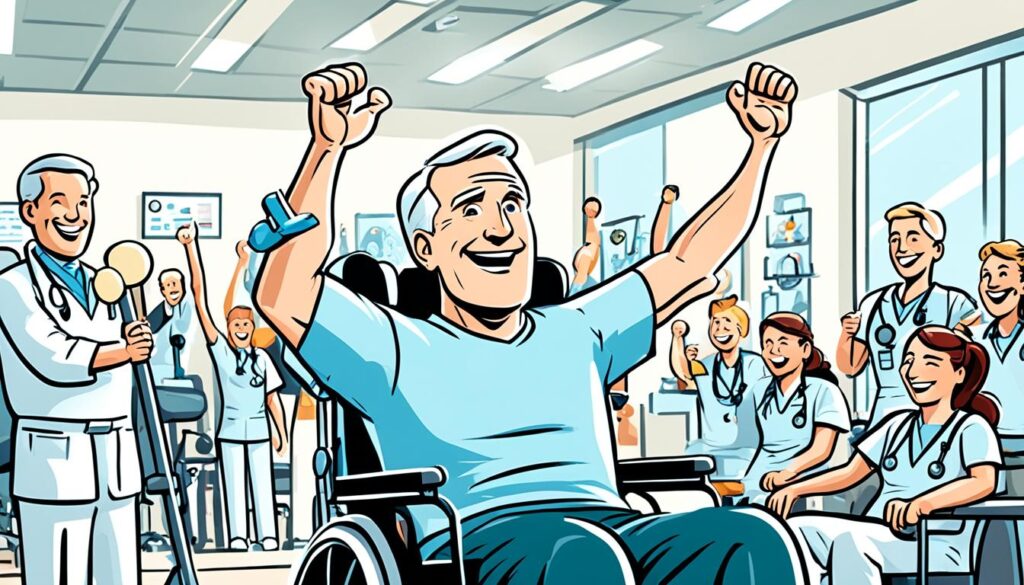If you’re unfamiliar with Guillain Barre Syndrome (GBS), it’s a rare but serious nerve problem. Our immune system wrongly attacks the peripheral nervous system. This leads to muscle weakness, numbness, and a tingling feeling. It can quickly get worse, causing paralysis and respiratory failure.
The exact causes of GBS aren’t fully known. It sometimes starts from an infection. A few examples are the Campylobacter jejuni bacteria or certain viruses. These may include the flu, Zika, or COVID-19. We call GBS an autoimmune disease, but what exactly triggers it is a bit of a mystery. The good part is that most people recover fully. Yet, some might be left with weakness or other issues. It’s really important to diagnose and treat GBS fast.
This article will look closer at the symptoms, causes, and treatments of Guillain Barre Syndrome. So you can understand it better and know its signs.
Table of Contents
ToggleUnderstanding Guillain Barre Syndrome
Guillain Barre Syndrome: A Rare Autoimmune Disorder
Guillain Barre Syndrome is a rare autoimmune disorder. Your body’s immune system attacks the peripheral nervous system. This system links your brain and spinal cord to your body. The attack damages the myelin sheath, a nerve’s protective cover, stopping nerve signals. This leads to symptoms like muscle weakness and paralysis.
The Peripheral Nervous System Under Attack
The immune system attacks the peripheral nervous system in Guillain Barre Syndrome. This causes problems like muscle weakness and tingling. Knowing how this disease affects the peripheral nervous system helps us understand its causes of guillain barre syndrome and symptoms of guillain barre syndrome.
Symptoms of Guillain Barre Syndrome
The start of Guillain Barre Syndrome symptoms often includes weak muscles and tingling. It usually kicks off in the legs and works its way up. Your muscles can get weak quick. This might make you stop moving your arms, legs, and even have trouble breathing.
Progressive Muscle Weakness and Tingling Sensations
A key sign of this syndrome is how your muscles get weak over time. You could feel tingling or numbness in your legs first. Then, it might spread to your stomach, chest, and arms. This can get so bad that you find it hard to move, walk, or take a breath on your own.
Potential Respiratory and Swallowing Complications
After a while, the weak muscles might make breathing and swallowing tough. Sometimes, those with Guillain-Barré need help to breathe. Others might find swallowing food or water hard. This can lead to more problems, needing special care.
Varying Degrees of Severity
Guillain-Barré affects each person differently. For some, it brings a little muscle weakness and tingling. But for others, it leads to almost being unable to move, which is an urgent issue. The worst symptoms usually hit in the first two weeks. Most start to get better in a few weeks to several months. But, some might need years to fully recover.

Guillain Barre syndrome
Guillain Barre Syndrome’s source is a mystery. Doctors think it starts after the body fights an infection. Illnesses like Campylobacter jejuni, the flu, Zika, and COVID-19 often come before GBS. Very few people might get GBS after certain shots, like the flu or Johnson & Johnson and AstraZeneca COVID-19 vaccines. Still, the risk is very low. GBS can happen to anyone. But, it’s likelier as you get older and more often found in males.
Causes and Risk Factors
Experts believe GBS starts when our immune system attacks our own nerves by accident. This happens after fighting off an infection. Illnesses caused by viruses and bacteria, like Campylobacter jejuni, the flu, and Zika, are often linked to GBS.
Viral and Bacterial Infections as Triggers
Before GBS shows up, about two-thirds of patients feel like they have an infection. Such sicknesses, especially those from viruses and bacteria, may fire up the body’s attack on its nerves. It’s essential for doctors to understand how infections can lead to GBS. This helps them treat it better.
Rare Association with Certain Vaccines
In very rare cases, some vaccines have been tied to a small increase in GBS risk. This includes the flu shot and Johnson & Johnson and AstraZeneca COVID-19 vaccines. But, the protection these vaccines offer against severe illnesses is much more important than the tiny GBS risk.

Diagnosis and Treatment
Doctors diagnose Guillain Barre Syndrome (GBS) with a close check-up, nerve tests, and fluid studies. They look at your symptoms and past health. Tests are done to confirm GBS, which guides the treatment plan. This process is very important.
Clinical Examination and Diagnostic Tests
At first, your doctor does a physical exam. They check your muscles, reflexes, and how you feel. Nerve tests may also be ordered. These check how well your nerves work. A spinal tap tests your spinal fluid, looking for signs of GBS.
Plasma Exchange and Intravenous Immunoglobulin Therapy
After GBS is found, quick treatment is key. Plasma exchange and IVIG are two main therapies. Plasma exchange takes out bad antibodies from your blood. IVIG therapy gives your body good antibodies to fight the bad ones. These treatments help your nerves heal.
Supportive Care and Rehabilitation
Along with specific GBS treatments, supportive care is vital. Breathing help might be needed, especially early on. Once stable, rehab to get your strength and movement back is important. Physical and occupational therapy can help you through this.
Most GBS patients fully recover, especially in walking and motor skills, within a year. However, some may take longer to fully heal. For those who properly manage GBS promptly, the chance of a full return to health and independence is high.

Conclusion
Guillain Barre Syndrome is a rare, dangerous disorder that attacks the body’s nerves. Its reason for happening is not fully understood. This syndrome can start after someone gets sick with the flu, Zika, or COVID-19.
Symptoms often begin with weak muscles and a tingling feeling. If not treated quickly, it can lead to paralysis. This is when the body can’t move, and it’s a serious problem that needs medical help right away.
It’s vital to get a fast diagnosis and start treatment promptly. This might involve getting a plasma exchange or immunoglobulin therapy. Luckily, most people do make a full recovery, even though some might have lasting weakness or other problems.
Knowing the signs, what causes it, and the treatments is key. This ensures people with Guillain Barre Syndrome get the help they need. Though it’s rare, it’s a serious health issue that demands attention.
For those with Guillain Barre Syndrome, their outlook is usually good. Many fully recover. Still, a few might face lasting muscle weakness or other nerve issues. Thanks to new research and treatments, the future looks brighter for those with this condition.
FAQ
What is Guillain Barre Syndrome?
What are the symptoms of Guillain Barre Syndrome?
What causes Guillain Barre Syndrome?
How is Guillain Barre Syndrome diagnosed and treated?
What is the prognosis for Guillain Barre Syndrome?
Source Links
- https://www.mayoclinic.org/diseases-conditions/guillain-barre-syndrome/symptoms-causes/syc-20362793
- https://www.ninds.nih.gov/health-information/disorders/guillain-barre-syndrome
- https://www.ncbi.nlm.nih.gov/books/NBK532254/
- https://www.hopkinsmedicine.org/health/conditions-and-diseases/guillainbarr-syndrome
- https://www.mayoclinic.org/diseases-conditions/guillain-barre-syndrome/diagnosis-treatment/drc-20363006
- https://www.who.int/news-room/fact-sheets/detail/guillain-barré-syndrome

Best Neurologist Doctor In Patna: Dr Chandril Chugh Dedicated to Your Well-being
Dr.Chandril Chugh is a neurologist who trained and practiced in the USA for more than a decade. He is compassionate and caring and is most well known for being a patient listener and spending ample time with patients.
